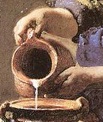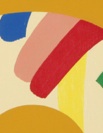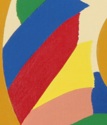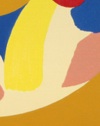The meta of art



Sometimes greatness is so obvious that people from all walks of life recognize it instantly. In the arts this is a rare phenomenon, but it exists. Not in an artist like Van Gogh. The masses that come and have a look at his sunflowers do believe that he is a great artist, because this is told to them, time and again. The best case of a general awareness of true greatness in the arts is Vermeer. Even the most illiterate beholder of his paintings senses that there is something about them and that this something is probably best described by something called greatness. No matter how great, not even the paintings of Rembrandt provoke this same awareness; at least not in the masses that come to have a look at his Night watch. They too have to hear, time and again, how great Rembrandt is, to (hopefully…) see his greatness. Only highly enigmatic Vermeer ‘put something in his paintings’ we cannot escape from, something of a higher order, obviously touching things so essential to us that they speak to all of us. This something of a higher order, I call the meta of art. Normally it is the phenomenon accompanying art that the masses are the least susceptible to. Only in Vermeer it, miraculously, gets to the surface of our awareness in an inescapable way, even if we are not hard-core art lovers.
The meta of art transcends skill, it transcends the little find, the clever move, the showy gesture; it transcends all the basics of art (and way beyond) and whatever vanity there may be attached to it. It is only in the meta of art that an artist really finds an expression for the mystery of our existence. But he cannot find the heart and soul of this expression on purpose. Purpose is way too much connected to skill, gesture, vanity. The essence of the meta of art is only to be found accidentally, by a mind being able to bring all that is essential together in a most natural of ways, which even escapes his own understanding. This mind is principally characterized by openness. It does not push towards what it wants to express of its skills, its convictions, its believes, it ‘just’ wants to explore as limitless as possible. That is why there is always the element of amazement at the heart of the meta of art. The artist knows that there is a lot he does not know and, one way or the other, has been able to express this lack of knowledge in a way that makes the susceptive beholder eager to look a little longer along the pointing finger of the artist instead of turning away in disappointment. The not knowing of the artist, in a twisted way, seems to represent a higher order of knowing – the kind of knowing Socrates is said to have pointed out as the Olympus of knowing… Vermeer painted the unknown in such a way that we all – in our very own right… - feel it, despite the fact that we do in no way understand it. And with this Vermeer is one of those extremely rare artists that have been able to grab the tail of the mystery of our existence in such a way that they seem to be able to show us the contents of this mystery. Of course they can’t. Art is, as the great Picasso said, always a lie. But still, to be able to suggest that you present the contents of the mystery of our existence, your art has to ‘contain’ a huge amount of the meta of art.
The democratic movement in the arts, since 1917 telling us that art is everything we call art, may have brought forth more art of a certain level than ever, it also has diminished the level of the meta of art in the higher regions of art. There is hardly any – if there is any at all… - meta of art to be found in the art of Andy, Jeff, Damien, Cindy, Tracey, Luc, Guido, and the like. No matter how much their art is celebrated, compared to the meta of art found in the art of Mondrian, Rothko, Bacon and even Freud, there is not much that transcends the ego of the named artists. Their art is too well thought of, too busy to make a certain impression on the beholder, too aware of a certain programme it has to represent. O yes, the paintings of Bacon fitted a certain psychological programme as well - of course, no artist escapes his personality… But outside this psychological programme here and there are traces of phenomena that transcend the drinking, gambling, horror-obsessed mind of old Francis. In other words: there is quite a lot of the meta of art that lifts the paintings of Bacon way above the doings of all-too-human creative Francis. Do not try to find such phenomena in the art of Andy. They do not exist. Despite the supposed clairvoyant abilities of silver haired Andy, his art did not get away from what he wanted with it. As far as Andy-connoisseurs are concerned, the supposed emptiness of Andy’s art has to be seen as a kind of transcendental expression of the existential emptiness of the society in which it was rooted. Sounds very good, and I’ll grant them that Andy had his finger at the pulse of his time (at a certain place in the world…) But that’s exactly the problem with someone like Andy: he does in no way transcend his time. Back to Vermeer, we see him paint a lot of the emblemata 17th century Dutch art lovers understood and therefore liked. And so his paintings catch, in a way, part of the spirit of the Dutch bourgeois city culture of those days. But this is, in Vermeer, only the beginning. On top of this, there is something expressed that lifts his art high above the art of other great painters of his days like Steen, Dou and de Hoogh, who all had their finger at the pulse of Vermeer’s age, but were in no way able to transcend it. Vermeer could. And he did. Andy couldn’t. And so the art of Vermeer is not just different from the art of Andy, more importantly it is of a much higher order than Andy’s. And so it is only because of silly economical reasons in combination with the just as silly workings of fashion that works of Andy may become just as expensive as works of Vermeer - if ever they would leave the museums they are at home now…
At the moment, walking the floor of one of the great art fairs of the world, there is a lot happening in the contemporary arts, but it is all happening within boundaries not even close to where the meta of art takes off. And in this situation, where the meta of art seems to have lost its fertile ground in the minds of the contemporary artists, Meta-art comes along.
Where the meta of art in the paintings of even Vermeer is a kind of cherry on top of the whipped cream on top of the pastry, in the Meta-paintings of Marianne Schuit the meta of art has escaped the pastry and the whipped cream entirely, leaving at most a little bit of the whipped cream at the skin of the cherry; a small reminder of where it ever so subtly is rooted in: art.
Meta-art, however accidentally brought to light, is the one and only creative expression that is taking the meta of art to even higher time-defying levels than it had already reached in the art of someone like Vermeer. And one might wonder if it is really accidentally that Meta-art has developed only just now, now the meta of art has no possibility anymore to root in the art of contemporary artists, or that it was provoked in the mind of Marianne Schuit to, for heaven’s sake, come out and pull the visual arts by their own hair out of the swamp of democratic ignorance.
If art has lost her ability to be a fertile ground for the meta of art, it is because in the 20th century we have come to love art for all sorts of wrong reasons. If we love art in the wrong way, we do not support her - we support all sorts of other things, but not her. Like a child that we love in the wrong way, we will either spoil her or leave her in the cold. Either way we will take her spirit away, the spirit from which the meta of art rises. Which, actually, has happened while we were celebrating the young Brits, who got out to challenge the dynamic media-society they were a dynamic part of. And, o yes, they got their share of the contemporary attention. But they never got any of the fabulous magic that Vermeer poured out on his canvasses from a life that, no matter how little we know of him, most probably has been a shockingly boring bourgeois life. In this respect Vermeer is a thorn in the flesh of all those minds who sincerely believe that a great artist, let’s say someone like Van Gogh, is always someone who is pretty weird. They do not know what they are talking about when it comes to great art, having learned to love art for all sorts of wrong reasons. Great art, art blended with considerable amounts of the meta of art, does in no way let itself and its creator be categorized in order to make them more understandable to us. She does as she pleases, wherever she pleases, whenever she finds a mind that is able to grant her this ultimate freedom. Mad man, bourgeois husband, arrogant troublemaker, if his or her mind has the capacity to clear the way through all this, to create her a free passage, great art will be at home there, despite all of its banal mental neighbours.
At times that the ocean deep depths of art at best have become lukewarm lagoons, Meta-art is taking the meta of art into dimensions never thought possible. The sheer complexity, the utter subtlety, of these dimensions makes it very hard, even for a trained and highly susceptive art lover, to get in touch with the all-embracing mental riches that has found its expression in these dimensions. Not of this world, indeed. Even more than in the grand art of Vermeer. But just as in his art, in Meta-art there is this strong notion of a most natural beauty that seems to be the immaterial intermediate between us and the essence of our existence.
Vermeer is badly understood, as we all know. We see the greatness of his art, it is nothing but obvious. But his subtleness leaves us behind unaware of what he is really touching. And I am sure that the Vermeer-connoisseurs, who know this very well, are not yet really aware of how much further the enigma of Vermeer is reaching than they already think it does. The prostitute, the milkmaid, everything they have said about those enigmatic women, only just touches the beginnings of what they represent. It is the fabulous technique, the mysterious light of Vermeer that keeps his connoisseurs under his spell. But that’s only where Vermeer’s meta of art starts.
In the Meta-art of Marianne Schuit the situation is even worse, much worse. Since her Meta-paintings have no starting point in such phenomena as ‘fabulous technique’ and ‘mysterious light’, the connoisseur is entirely in the dark from the beginnings. Four centuries of scientific development have taken the meta of art entirely away from the visible. Vermeer did not know of Freud, DNA, quantum physics, neurology. Marianne Schuit does. She has become deeply aware of the fact that the meta of art, which is so strongly connected to the essence of our existence, is entirely rooted in the invisible. The bread of Vermeer, his milk, they are, in a highly enigmatic way, symbolic. But symbols belong to the visible. In Meta-art there are no symbols, because the essence of what we live is rooted much deeper than what can be represented by some image from reality.
And so the unbelievable shallowness of contemporary art makes place for the unbelievable profundity of Meta-art. The enigma, already huge in Vermeer’s 17th century Delft, has only multiplied in Marianne Schuit’s 21st century Amsterdam. But beware! Do not think that this text suggests that the art of Vermeer and Meta-art can be compared with each other in depth. Art is constantly trying to escape from the prison of its own possibilities – which Vermeer has done marvellously -, but Meta-art is constantly staying out of this prison. Looking through the window of his art Vermeer has brought the sun into his room as if he met it free as a bird. But everybody who thinks twice knows that birds are never free, not even when they fly high in the sky. Marianne Schuit, however, being the only Meta-artist ever, is where the sun is. She does not have to lead it into her room. She is the very first creative mind that is totally free from the limitations of the medium. More meta art has never been. And will, probably, never be anymore.






